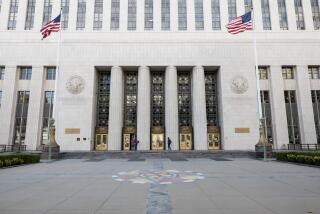Justice takes a day off
- Share via
Starting Sept. 16, the largest court system in the nation will be closing the doors of courthouses across the state one day each month. On Wednesday, an estimated 3 million cases will be delayed, 150 jury trials interrupted and 250 child custody cases unheard. Jails will be more crowded as arraignment and release dates are postponed; attorneys and their clients will be inconvenienced, as will jurors; and the public will experience longer lines, more delays and more crowded courtrooms.
Wednesday is the first of 10 monthly statewide closure days (uniformly the third Wednesday of each month) authorized by the Judicial Council, the constitutionally created body that administers California’s court system. As in many other states, the council was created in the 1920s, an outgrowth of the Progressive movement, which sought to make government more efficient, more effective and more accountable. The mission of the council today remains largely unchanged: to ensure the consistent, impartial and accessible administration of justice in the state.
Why then is the council, a body created to protect and increase access to justice in California, allowing our courts to close for even one day a month?
California’s economic crisis has affected government at all levels and in nearly every area of service, as well as every aspect of private life and business. For seven months, Californians have endured the effects of mandatory furloughs for many state workers, first two days a month and now three. But courts are not state agencies. And courthouses -- known earlier in our history as “temples of justice” -- are not just office buildings; they are the repository of our fundamental commitment to justice for all. The unintended yet inevitable symbolism of “Closed” signs on institutions that embody our democratic ideals is yet another tragic indicator of the severity of California’s economic crisis.
The Judicial Council, with express authorization from the Legislature and the governor, made the difficult decision to close courts one day a month to avoid even more damaging consequences of reductions in the judicial branch’s budget. This course of action was taken with great reluctance at an emergency public meeting in July, after substantial input from local courts and after months of examining alternatives. In the end, court closures proved to be the only rational option available to address budget realities while protecting skilled employees from massive layoffs, maintaining a consistent level of court services for litigants and their lawyers, and preserving equal access to justice. Indeed, the Superior Court of Los Angeles County had already concluded that closures were inevitable and in July became the first court in the state to implement monthly closures.
At the emergency meeting, I pledged to reduce my own salary to share in the sacrifice we are asking of the majority of the 21,000 men and women who work in the California judicial branch. I also encouraged my judicial colleagues across the state -- more than 1,600 trial judges and an additional 111 appellate justices -- to join me in voluntarily waiving their salaries for one day a month or donating a portion of their salaries to support court operations. I am gratified to report that a very high percentage of the judges in the state have pledged to either participate in the waiver or to make private donations to their respective courts. As The Times recently reported, that figure is exceptionally high in Los Angeles, where 423 of the 430 judges are participating in voluntary pay reductions.
At this critical juncture in our state’s history, even as the judicial branch is forced to close courts one day a month, the state court system itself remains stronger and better able to deliver on the promise of equal justice under law because of the many changes we have made in the last several years. In the years I have served as California’s chief justice and chairman of the Judicial Council, the judicial branch has undergone the most significant structural reforms in our state’s history.
The court reforms of recent years rival those of the Progressive era and will exceed them in the benefits they provide to the public. Legislation in 1997 that allowed for statewide funding of the trial courts addressed historic inequities in the quality of justice dispensed among California’s 58 counties. In 1998, California voters approved an amendment to the state Constitution to permit the unification of the 220 Superior and Municipal courts into 58 trial courts -- one in each county. Unification has allowed greater flexibility in the use of judicial and staff resources, eliminated duplicative services and led to the creation of additional services for the public, such as collaborative justice courts, domestic violence courts, drug courts and complex litigation courts. Finally, the Trial Court Facilities Act of 2002 called for the transfer of responsibility for court facilities from the counties to the state. This allowed the judicial branch for the first time to assume responsibility for the buildings in which judges and court staff work and the public is served, and to do so economically and effectively. To date, 503 (more than 90%) of our court structures have been transferred to the state’s ownership under judicial branch management.
These historic changes and the growing responsibilities of the council have been a means to an end. They have strengthened the judiciary as a coequal and independent branch of government and secured the system of checks and balances essential to a robust democracy. They have addressed budget inequities among trial courts around the state. They have improved our branch’s accountability to our sister branches of government for the financial appropriations provided to the courts. And ultimately they have enhanced equal access to justice and provided a greater degree of accountability.
One irony of the current crisis is that it restricts court services at a time when the need for them is increasing. The economic downturn has produced a sharp spike in civil filings, especially in the areas of contract and unlawful detainer, which includes evictions. This increase has more than offset a small decline in criminal filings. What this means to judges and court staff is that we are asking them to do more with less. What this means for all Californians is that we must provide adequate resources for courts to resolve disputes in an orderly manner, or suffer the consequences of being unable to meet the public’s needs.
When I served as a trial judge in Los Angeles during the 1970s and ‘80s, California was still in its age of abundance. Today we are in a far more challenging time. The fiscal crisis in our state will have profound effects on many aspects of public service, including the courts, in the next fiscal year and for several years to come. I am committed to protecting the public from the full impact of further reductions in court services, and from any decline in the high quality of justice that so many have worked so long to achieve.
My hope is that as we are tested by this crisis, all of us -- state government officers, justices and judges, court employees and Californians everywhere -- will join together in meeting these challenges. How we proceed will tell us a great deal about the prospects for our state in the years ahead.
More to Read
Get the L.A. Times Politics newsletter
Deeply reported insights into legislation, politics and policy from Sacramento, Washington and beyond. In your inbox twice per week.
You may occasionally receive promotional content from the Los Angeles Times.










